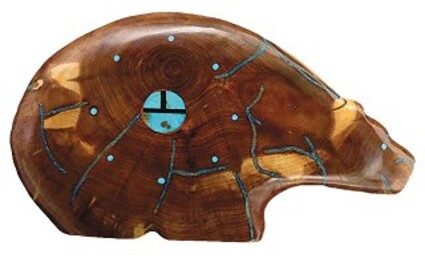From the Zuni Pueblo: Mystery, artwork, and love
Last updated 10/24/2017 at Noon
Discussing an unfamiliar subject without background, Zuni artwork for instance, is like telling a newcomer from the Amazon about powder conditions on Hoodoo and snowboarding.
Art or an exotic outdoor event can be a portal for visualizing the beyond - but only if context about what's viewed is provided. There are times, however, when contextual facts are sparse, as is the case with both the history and culture of the Zuni Pueblo.
This type of paradigm then offers something rare: a true enigma.
Indigenous cultures typically hold a different perspective from ours regarding sharing, privacy, and what we call "transparency," both at the individual and societal level. The Zuni people of New Mexico have an obscure origin; they prefer to remain mute on understandings about various topics. So-called facts about their spiritual matters are recorded but are far from complete, to the dismay of researchers. An example of all this is their language, A:Shiwi. It has no known lineage or family member, thus making it a language isolate. They have been "their own People" for at least 7,000 years, similar to the Basques of Western Europe.
Facts that we do know about the Zuni can be fairly peculiar to us. They are a matriarchal society; women own all property and material wealth along with lineage rights. When a marriage occurs, the husband moves to, lives with, and becomes part of the wife's family. Estimates are that 80 percent of all households have at least one family member who is a stone/wood carver, jeweler, potter, or painter; most have more than one.
This makes the community, per capita, one of the richest artist enclaves in the United States.
The people that the Zuni identify with culturally and spiritually are the Hopi, yet, the languages are altogether different. Finally, the Zuni have long had the reputation of being exceptional, proud warriors and protectors of ancient trade routes. They fended off incursions for millennia, and most recently turned back the Navajo, Apache, and Spanish. So nothing intrudes with any depth upon them, their lands or the culture - with the possible exception of love.
Forty years ago, a young Navajo woman attending the University of New Mexico went to the Pueblo for a weekend stay with a Zuni girlfriend. There, the Navajo woman, named Jayne Quam, met a Zuni man named Lynn - and she never left. Considering that the Navajo are also a matriarchal society, it does not happen that a wife goes to live where the husband is. But it did happen. And she's still there. Jayne Quam not only stayed and made a life with Lynn, she learned from him how to make the centuries-old tradition of small stone carvings depicting animal spirits, known as Zuni fetishes.
Their daughter, Kandis, earned a degree in anthropology from the University of New Mexico. She became a painter and has taken the Zuni image making - first done in with colored pencils and within a Realism context 70 years ago - into a deeper and joyful reflection of her modern world. Elroy Natachu, Jr. is the nephew of Jayne and Lynn. Through contemporary perspectives, he has dedicated himself to the preservation of the culture and in particular the Zuni Kachinas. Together, they have formed the art partnership, Natachu Ink.
Today, collectors of Native American art often have a special stone carving of an animal, bird or icon they may have purchased in the Southwest. These well-known carvings, or fetishes, demonstrate both a Zuni artist's skill and deep cultural connection with the natural world. Depicting these embellished objects or amulets-in particular mountain lion, coyote, wolf, badger, eagle, and mole, each one serving as the hunter/guardian at one of the six directional regions of Zuni cosmology - has been occurring since pre-Columbian times.
Two types of Zuni fetishes are carved today. Traditional fetishes are of local stone, which are simply shaped, and then carefully kept while respecting the living object represented. Not to be confused with good-luck charms or magic amulets, these particular Zuni stone fetishes offer a more complex and ceremonial purpose: to assist humans with blessings, natural balance, and focus - since we are considered the most vulnerable of living creatures in Zuni culture.
Art market fetishes, more stylized and embellished, are prized items for collectors of Native American art, animal lovers, and tourists to the Southwest. These Zuni sculptures are created either from stone, fossil, or antler. Particular animals, birds or icons may reflect a special bond or connection that a carver has with the natural world. For instance, one highly prized carver makes salmon and trout pieces, though he's spent his entire life in the desert Southwest. Other carvers become renowned for their unique forms and stylizing when depicting our world's creatures, Jayne and Lynn Quam being two of these acclaimed artists.
Jayne's fetishes have the unique feature of mosaic inlaid stonework, a style more commonly seen in Kewa (Santo Domingo Pueblo) jewelry. Lynn mostly carves buffalo. Which can be like saying Bob Dylan writes songs. Many Zuni artists have carved buffalo, but Lynn's are it. A quiet man, his health can be up and down at this point in life, so he has to be careful about traveling. Jayne, Kandis, and Elroy will be in Sisters for a three-day in-person show at Raven Makes Gallery, October 27-29, coinciding with the Fourth Friday Art Stroll.

















Reader Comments(0)